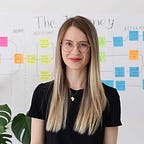In UX Design We Never Show Up Empty-Handed
The art of the first interview using a conversational object
Storytelling is undeniably one of the most desirable skills for a designer. Being a good storyteller makes it easier to communicate research findings, convey design ideas and ensure the best service for your customers. But what if you need to tell a story at a very early stage of the project, when there is only little data in hand. Oh, and the story should also be an object…
In September 2020 I started a new career joining the Digital Society School as a UX Design trainee. I have been involved in a project aiming to help teachers from vulnerable population deliver good quality online education during and after pandemic times. After a couple of weeks of engaging workshops immersing us into design thinking, scrum and professional development, we got a hands-on task to prepare a conversational object for the first interview.
What a conversational object is, according to Digital Society School:
- It is a design artefact, used as a part of research, which can help understand the problem.
- Knowledge, assumptions and existing research wrapped up as a performance, single object, game, or all of this together.
- Ingredients for a conversational object can employ: paradoxes, exaggerations, uncertainties, humor, speculations, science fiction.
What a conversational object is not:
- It is not a first draft of the final solution, especially if you are at the very early stage of product development.
The task felt too artistic at first, but then I started thinking of a conversational object as a homemade cake (rare plant cutting, souvenir from overseas, etc) that I would take to a friend’s party. Not for nothing has my mom taught me to never show up empty-handed. Bringing something, whether to a party or a first interview, would definitely spark a conversation: we would try the cake and discuss the recipe, chat about plant care, dream about our next trip. All in all, an interview is not very different from visiting a long-time-no-see friend.
What our creative process looked like
In the beginning was brainstorming, and that is where we struggled. Our project seemed very broad in the beginning, and, rather than mapping the data we already had, we jumped into questions. So, the “Everything We Know” board looked more like “Everything We Want To Ask”, and we were obviously not going anywhere.
Then the team decided to take a step back, breath in and out, and deconstruct the problem to get to the essence of it. In a nutshell, education is a teacher passing down knowledge onto students. In the face-to-face environment teachers are more or less in control of the situation: they see students’ face expressions and body language, if students work or cheat, focused or distracted. Online education takes almost all of this away, and, with all its obvious benefits, can make both parties feel lost and unmotivated.
Several hours of thinking in that direction and many sketches later, we came up with an idea of a performance that could scratch the surface of the problems that people encounter when teaching online. Our concept aimed to show the difference between offline and online education, roughly depicting problems that can occur if the transition between the two was an emergency rather than a planned act. Now it was a matter of bringing the concept to life.
What we learnt (the important part)
Creating a conversational object turned out to be a very exciting journey, which came bearing some nice benefits:
- We definitely boosted our team’s collaboration skills to the next level.
- It helped us discover more about the problem. Everyone who saw
the video were willing to share some insights from personal experience. - It was a good tool to test our early assumptions about the users and user outcomes.
But what about the interviews…
We already used the video in several interviews, and every time it would set
a very good tone for the conversation. People could relate to what we showed in the video, laughed and told us more about unexpected forms that online education can take in the absence of proper preparation.
Thanks for reading!
Clap👏 👏 👏 if you liked the article and share what your thoughts are in the comments :)
